What is Critical Appraisal?
VerifiedAdded on 2022/08/13
|8
|2005
|15
AI Summary
Contribute Materials
Your contribution can guide someone’s learning journey. Share your
documents today.
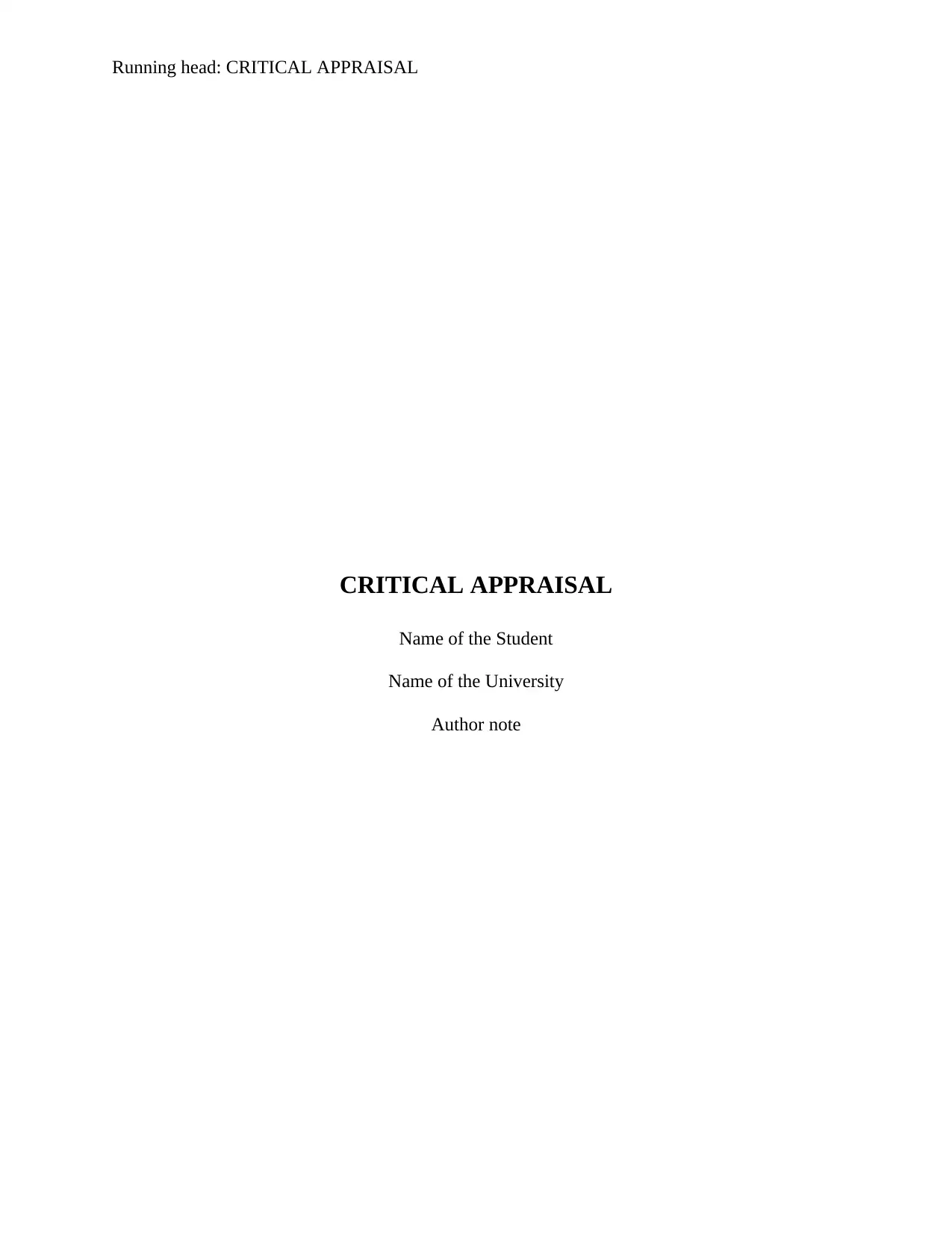
Running head: CRITICAL APPRAISAL
CRITICAL APPRAISAL
Name of the Student
Name of the University
Author note
CRITICAL APPRAISAL
Name of the Student
Name of the University
Author note
Secure Best Marks with AI Grader
Need help grading? Try our AI Grader for instant feedback on your assignments.
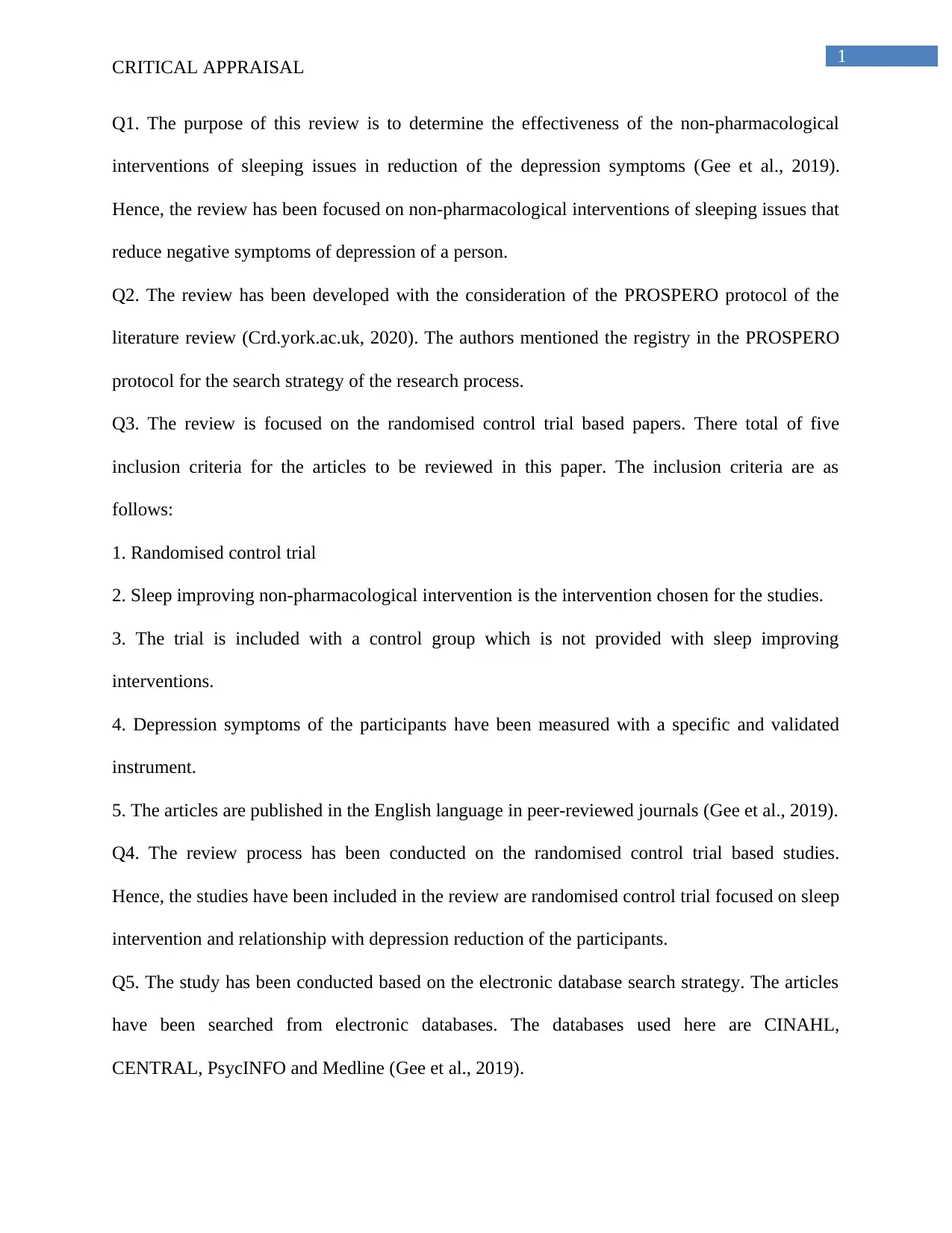
1
CRITICAL APPRAISAL
Q1. The purpose of this review is to determine the effectiveness of the non-pharmacological
interventions of sleeping issues in reduction of the depression symptoms (Gee et al., 2019).
Hence, the review has been focused on non-pharmacological interventions of sleeping issues that
reduce negative symptoms of depression of a person.
Q2. The review has been developed with the consideration of the PROSPERO protocol of the
literature review (Crd.york.ac.uk, 2020). The authors mentioned the registry in the PROSPERO
protocol for the search strategy of the research process.
Q3. The review is focused on the randomised control trial based papers. There total of five
inclusion criteria for the articles to be reviewed in this paper. The inclusion criteria are as
follows:
1. Randomised control trial
2. Sleep improving non-pharmacological intervention is the intervention chosen for the studies.
3. The trial is included with a control group which is not provided with sleep improving
interventions.
4. Depression symptoms of the participants have been measured with a specific and validated
instrument.
5. The articles are published in the English language in peer-reviewed journals (Gee et al., 2019).
Q4. The review process has been conducted on the randomised control trial based studies.
Hence, the studies have been included in the review are randomised control trial focused on sleep
intervention and relationship with depression reduction of the participants.
Q5. The study has been conducted based on the electronic database search strategy. The articles
have been searched from electronic databases. The databases used here are CINAHL,
CENTRAL, PsycINFO and Medline (Gee et al., 2019).
CRITICAL APPRAISAL
Q1. The purpose of this review is to determine the effectiveness of the non-pharmacological
interventions of sleeping issues in reduction of the depression symptoms (Gee et al., 2019).
Hence, the review has been focused on non-pharmacological interventions of sleeping issues that
reduce negative symptoms of depression of a person.
Q2. The review has been developed with the consideration of the PROSPERO protocol of the
literature review (Crd.york.ac.uk, 2020). The authors mentioned the registry in the PROSPERO
protocol for the search strategy of the research process.
Q3. The review is focused on the randomised control trial based papers. There total of five
inclusion criteria for the articles to be reviewed in this paper. The inclusion criteria are as
follows:
1. Randomised control trial
2. Sleep improving non-pharmacological intervention is the intervention chosen for the studies.
3. The trial is included with a control group which is not provided with sleep improving
interventions.
4. Depression symptoms of the participants have been measured with a specific and validated
instrument.
5. The articles are published in the English language in peer-reviewed journals (Gee et al., 2019).
Q4. The review process has been conducted on the randomised control trial based studies.
Hence, the studies have been included in the review are randomised control trial focused on sleep
intervention and relationship with depression reduction of the participants.
Q5. The study has been conducted based on the electronic database search strategy. The articles
have been searched from electronic databases. The databases used here are CINAHL,
CENTRAL, PsycINFO and Medline (Gee et al., 2019).
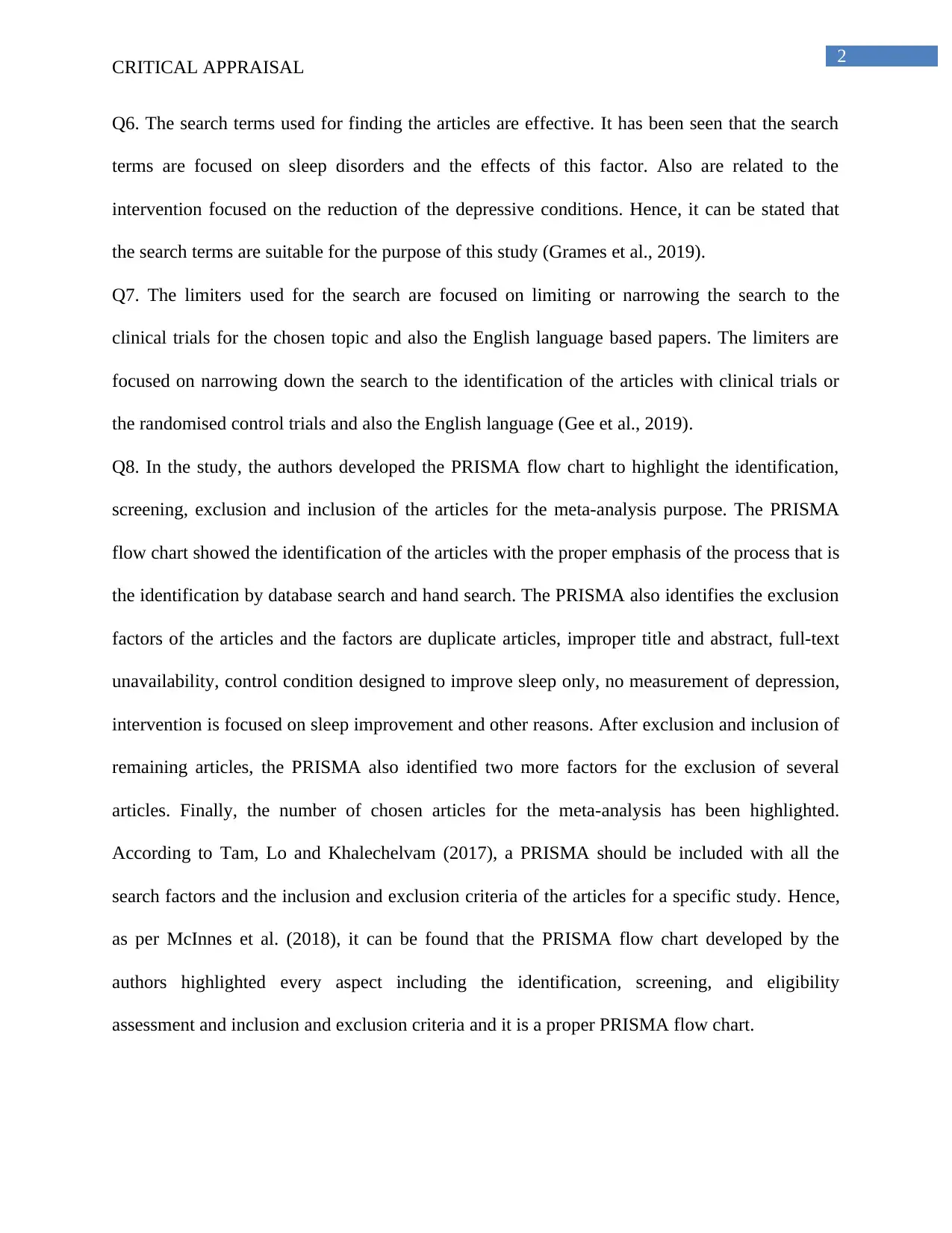
2
CRITICAL APPRAISAL
Q6. The search terms used for finding the articles are effective. It has been seen that the search
terms are focused on sleep disorders and the effects of this factor. Also are related to the
intervention focused on the reduction of the depressive conditions. Hence, it can be stated that
the search terms are suitable for the purpose of this study (Grames et al., 2019).
Q7. The limiters used for the search are focused on limiting or narrowing the search to the
clinical trials for the chosen topic and also the English language based papers. The limiters are
focused on narrowing down the search to the identification of the articles with clinical trials or
the randomised control trials and also the English language (Gee et al., 2019).
Q8. In the study, the authors developed the PRISMA flow chart to highlight the identification,
screening, exclusion and inclusion of the articles for the meta-analysis purpose. The PRISMA
flow chart showed the identification of the articles with the proper emphasis of the process that is
the identification by database search and hand search. The PRISMA also identifies the exclusion
factors of the articles and the factors are duplicate articles, improper title and abstract, full-text
unavailability, control condition designed to improve sleep only, no measurement of depression,
intervention is focused on sleep improvement and other reasons. After exclusion and inclusion of
remaining articles, the PRISMA also identified two more factors for the exclusion of several
articles. Finally, the number of chosen articles for the meta-analysis has been highlighted.
According to Tam, Lo and Khalechelvam (2017), a PRISMA should be included with all the
search factors and the inclusion and exclusion criteria of the articles for a specific study. Hence,
as per McInnes et al. (2018), it can be found that the PRISMA flow chart developed by the
authors highlighted every aspect including the identification, screening, and eligibility
assessment and inclusion and exclusion criteria and it is a proper PRISMA flow chart.
CRITICAL APPRAISAL
Q6. The search terms used for finding the articles are effective. It has been seen that the search
terms are focused on sleep disorders and the effects of this factor. Also are related to the
intervention focused on the reduction of the depressive conditions. Hence, it can be stated that
the search terms are suitable for the purpose of this study (Grames et al., 2019).
Q7. The limiters used for the search are focused on limiting or narrowing the search to the
clinical trials for the chosen topic and also the English language based papers. The limiters are
focused on narrowing down the search to the identification of the articles with clinical trials or
the randomised control trials and also the English language (Gee et al., 2019).
Q8. In the study, the authors developed the PRISMA flow chart to highlight the identification,
screening, exclusion and inclusion of the articles for the meta-analysis purpose. The PRISMA
flow chart showed the identification of the articles with the proper emphasis of the process that is
the identification by database search and hand search. The PRISMA also identifies the exclusion
factors of the articles and the factors are duplicate articles, improper title and abstract, full-text
unavailability, control condition designed to improve sleep only, no measurement of depression,
intervention is focused on sleep improvement and other reasons. After exclusion and inclusion of
remaining articles, the PRISMA also identified two more factors for the exclusion of several
articles. Finally, the number of chosen articles for the meta-analysis has been highlighted.
According to Tam, Lo and Khalechelvam (2017), a PRISMA should be included with all the
search factors and the inclusion and exclusion criteria of the articles for a specific study. Hence,
as per McInnes et al. (2018), it can be found that the PRISMA flow chart developed by the
authors highlighted every aspect including the identification, screening, and eligibility
assessment and inclusion and exclusion criteria and it is a proper PRISMA flow chart.
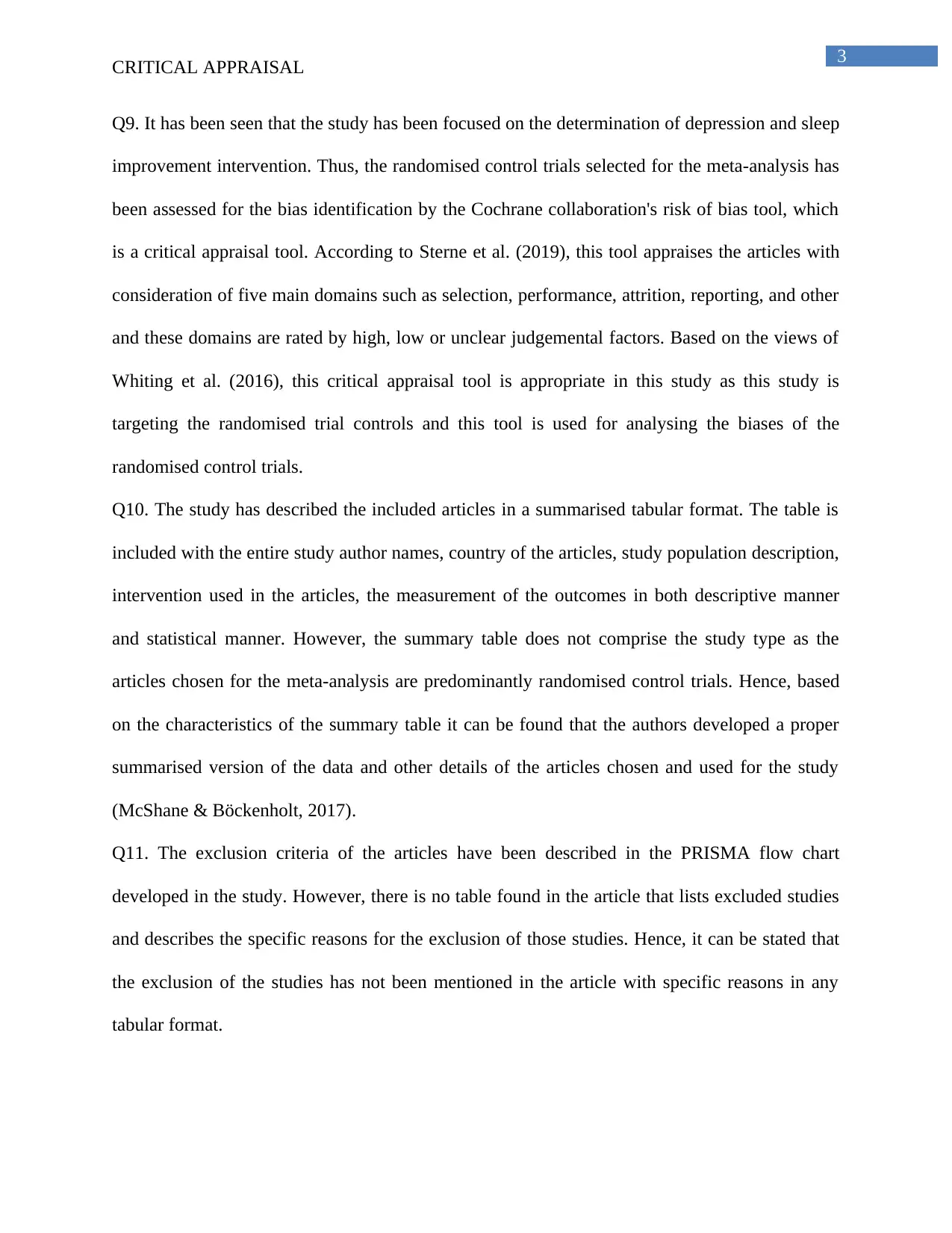
3
CRITICAL APPRAISAL
Q9. It has been seen that the study has been focused on the determination of depression and sleep
improvement intervention. Thus, the randomised control trials selected for the meta-analysis has
been assessed for the bias identification by the Cochrane collaboration's risk of bias tool, which
is a critical appraisal tool. According to Sterne et al. (2019), this tool appraises the articles with
consideration of five main domains such as selection, performance, attrition, reporting, and other
and these domains are rated by high, low or unclear judgemental factors. Based on the views of
Whiting et al. (2016), this critical appraisal tool is appropriate in this study as this study is
targeting the randomised trial controls and this tool is used for analysing the biases of the
randomised control trials.
Q10. The study has described the included articles in a summarised tabular format. The table is
included with the entire study author names, country of the articles, study population description,
intervention used in the articles, the measurement of the outcomes in both descriptive manner
and statistical manner. However, the summary table does not comprise the study type as the
articles chosen for the meta-analysis are predominantly randomised control trials. Hence, based
on the characteristics of the summary table it can be found that the authors developed a proper
summarised version of the data and other details of the articles chosen and used for the study
(McShane & Böckenholt, 2017).
Q11. The exclusion criteria of the articles have been described in the PRISMA flow chart
developed in the study. However, there is no table found in the article that lists excluded studies
and describes the specific reasons for the exclusion of those studies. Hence, it can be stated that
the exclusion of the studies has not been mentioned in the article with specific reasons in any
tabular format.
CRITICAL APPRAISAL
Q9. It has been seen that the study has been focused on the determination of depression and sleep
improvement intervention. Thus, the randomised control trials selected for the meta-analysis has
been assessed for the bias identification by the Cochrane collaboration's risk of bias tool, which
is a critical appraisal tool. According to Sterne et al. (2019), this tool appraises the articles with
consideration of five main domains such as selection, performance, attrition, reporting, and other
and these domains are rated by high, low or unclear judgemental factors. Based on the views of
Whiting et al. (2016), this critical appraisal tool is appropriate in this study as this study is
targeting the randomised trial controls and this tool is used for analysing the biases of the
randomised control trials.
Q10. The study has described the included articles in a summarised tabular format. The table is
included with the entire study author names, country of the articles, study population description,
intervention used in the articles, the measurement of the outcomes in both descriptive manner
and statistical manner. However, the summary table does not comprise the study type as the
articles chosen for the meta-analysis are predominantly randomised control trials. Hence, based
on the characteristics of the summary table it can be found that the authors developed a proper
summarised version of the data and other details of the articles chosen and used for the study
(McShane & Böckenholt, 2017).
Q11. The exclusion criteria of the articles have been described in the PRISMA flow chart
developed in the study. However, there is no table found in the article that lists excluded studies
and describes the specific reasons for the exclusion of those studies. Hence, it can be stated that
the exclusion of the studies has not been mentioned in the article with specific reasons in any
tabular format.
Secure Best Marks with AI Grader
Need help grading? Try our AI Grader for instant feedback on your assignments.
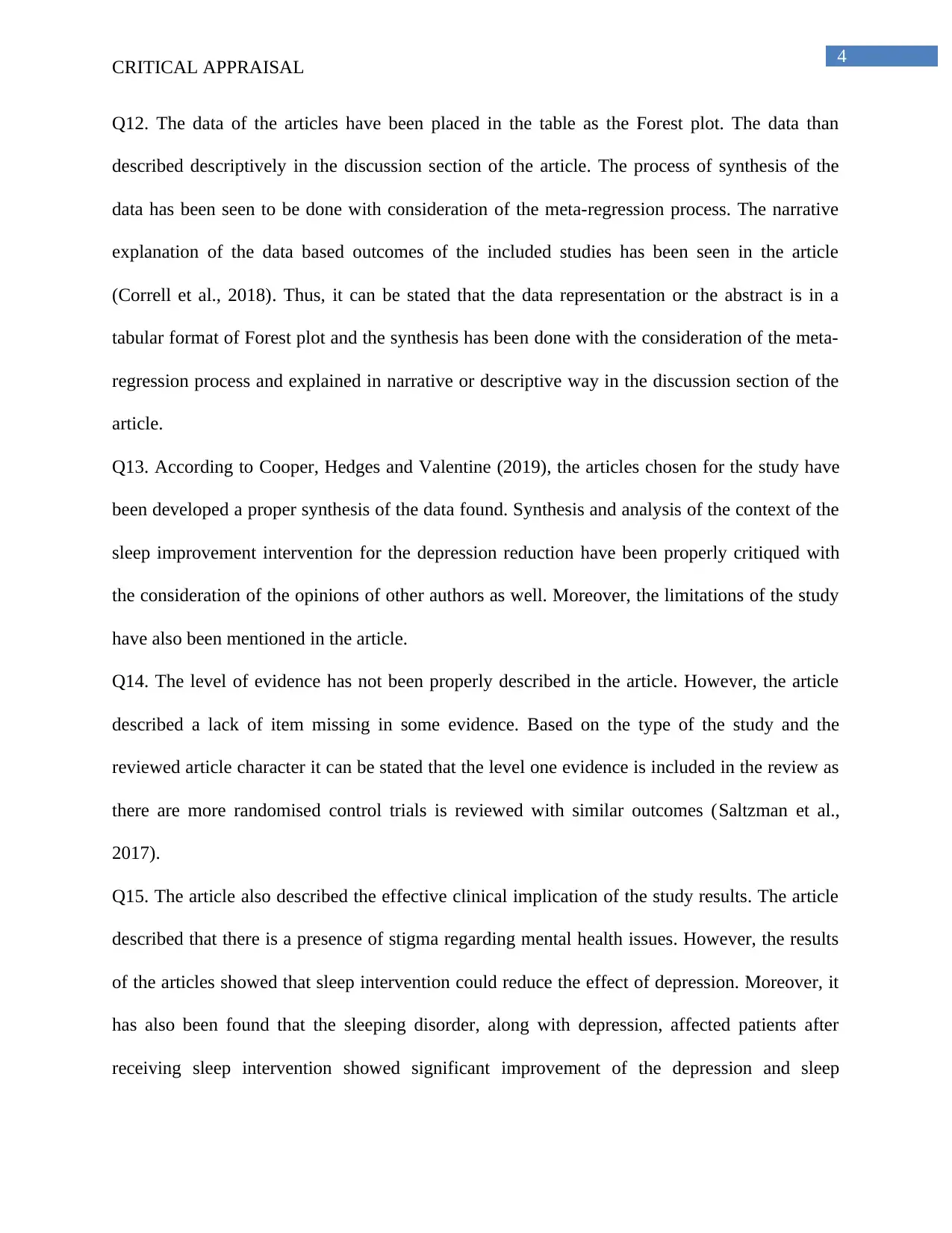
4
CRITICAL APPRAISAL
Q12. The data of the articles have been placed in the table as the Forest plot. The data than
described descriptively in the discussion section of the article. The process of synthesis of the
data has been seen to be done with consideration of the meta-regression process. The narrative
explanation of the data based outcomes of the included studies has been seen in the article
(Correll et al., 2018). Thus, it can be stated that the data representation or the abstract is in a
tabular format of Forest plot and the synthesis has been done with the consideration of the meta-
regression process and explained in narrative or descriptive way in the discussion section of the
article.
Q13. According to Cooper, Hedges and Valentine (2019), the articles chosen for the study have
been developed a proper synthesis of the data found. Synthesis and analysis of the context of the
sleep improvement intervention for the depression reduction have been properly critiqued with
the consideration of the opinions of other authors as well. Moreover, the limitations of the study
have also been mentioned in the article.
Q14. The level of evidence has not been properly described in the article. However, the article
described a lack of item missing in some evidence. Based on the type of the study and the
reviewed article character it can be stated that the level one evidence is included in the review as
there are more randomised control trials is reviewed with similar outcomes (Saltzman et al.,
2017).
Q15. The article also described the effective clinical implication of the study results. The article
described that there is a presence of stigma regarding mental health issues. However, the results
of the articles showed that sleep intervention could reduce the effect of depression. Moreover, it
has also been found that the sleeping disorder, along with depression, affected patients after
receiving sleep intervention showed significant improvement of the depression and sleep
CRITICAL APPRAISAL
Q12. The data of the articles have been placed in the table as the Forest plot. The data than
described descriptively in the discussion section of the article. The process of synthesis of the
data has been seen to be done with consideration of the meta-regression process. The narrative
explanation of the data based outcomes of the included studies has been seen in the article
(Correll et al., 2018). Thus, it can be stated that the data representation or the abstract is in a
tabular format of Forest plot and the synthesis has been done with the consideration of the meta-
regression process and explained in narrative or descriptive way in the discussion section of the
article.
Q13. According to Cooper, Hedges and Valentine (2019), the articles chosen for the study have
been developed a proper synthesis of the data found. Synthesis and analysis of the context of the
sleep improvement intervention for the depression reduction have been properly critiqued with
the consideration of the opinions of other authors as well. Moreover, the limitations of the study
have also been mentioned in the article.
Q14. The level of evidence has not been properly described in the article. However, the article
described a lack of item missing in some evidence. Based on the type of the study and the
reviewed article character it can be stated that the level one evidence is included in the review as
there are more randomised control trials is reviewed with similar outcomes (Saltzman et al.,
2017).
Q15. The article also described the effective clinical implication of the study results. The article
described that there is a presence of stigma regarding mental health issues. However, the results
of the articles showed that sleep intervention could reduce the effect of depression. Moreover, it
has also been found that the sleeping disorder, along with depression, affected patients after
receiving sleep intervention showed significant improvement of the depression and sleep

5
CRITICAL APPRAISAL
disorder conditions. Hence, it can be stated that sleep intervention can be very much effective for
depression reduction, and it is cost-effective in comparison to other interventions as well (Gee et
al., 2019).
CRITICAL APPRAISAL
disorder conditions. Hence, it can be stated that sleep intervention can be very much effective for
depression reduction, and it is cost-effective in comparison to other interventions as well (Gee et
al., 2019).
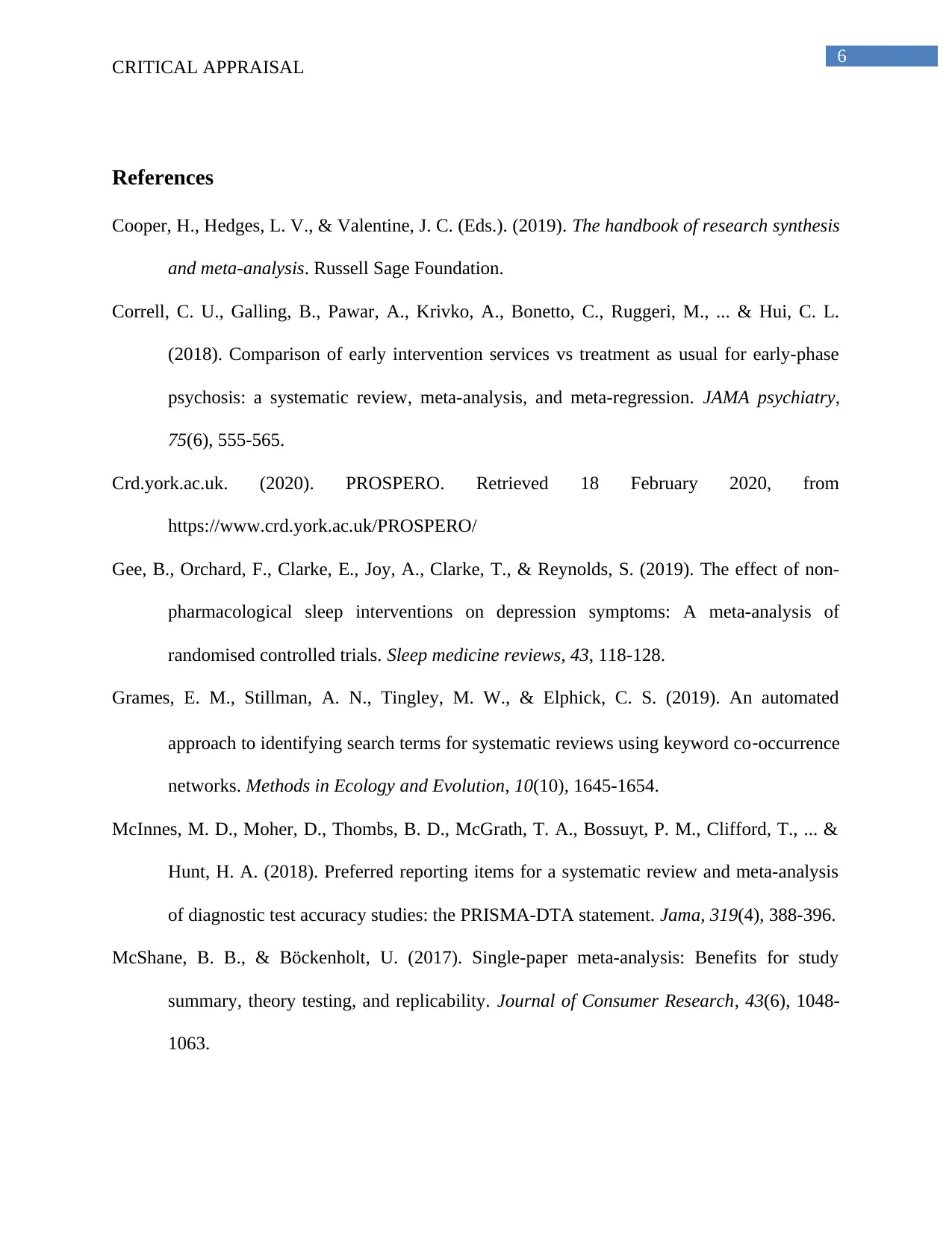
6
CRITICAL APPRAISAL
References
Cooper, H., Hedges, L. V., & Valentine, J. C. (Eds.). (2019). The handbook of research synthesis
and meta-analysis. Russell Sage Foundation.
Correll, C. U., Galling, B., Pawar, A., Krivko, A., Bonetto, C., Ruggeri, M., ... & Hui, C. L.
(2018). Comparison of early intervention services vs treatment as usual for early-phase
psychosis: a systematic review, meta-analysis, and meta-regression. JAMA psychiatry,
75(6), 555-565.
Crd.york.ac.uk. (2020). PROSPERO. Retrieved 18 February 2020, from
https://www.crd.york.ac.uk/PROSPERO/
Gee, B., Orchard, F., Clarke, E., Joy, A., Clarke, T., & Reynolds, S. (2019). The effect of non-
pharmacological sleep interventions on depression symptoms: A meta-analysis of
randomised controlled trials. Sleep medicine reviews, 43, 118-128.
Grames, E. M., Stillman, A. N., Tingley, M. W., & Elphick, C. S. (2019). An automated
approach to identifying search terms for systematic reviews using keyword co‐occurrence
networks. Methods in Ecology and Evolution, 10(10), 1645-1654.
McInnes, M. D., Moher, D., Thombs, B. D., McGrath, T. A., Bossuyt, P. M., Clifford, T., ... &
Hunt, H. A. (2018). Preferred reporting items for a systematic review and meta-analysis
of diagnostic test accuracy studies: the PRISMA-DTA statement. Jama, 319(4), 388-396.
McShane, B. B., & Böckenholt, U. (2017). Single-paper meta-analysis: Benefits for study
summary, theory testing, and replicability. Journal of Consumer Research, 43(6), 1048-
1063.
CRITICAL APPRAISAL
References
Cooper, H., Hedges, L. V., & Valentine, J. C. (Eds.). (2019). The handbook of research synthesis
and meta-analysis. Russell Sage Foundation.
Correll, C. U., Galling, B., Pawar, A., Krivko, A., Bonetto, C., Ruggeri, M., ... & Hui, C. L.
(2018). Comparison of early intervention services vs treatment as usual for early-phase
psychosis: a systematic review, meta-analysis, and meta-regression. JAMA psychiatry,
75(6), 555-565.
Crd.york.ac.uk. (2020). PROSPERO. Retrieved 18 February 2020, from
https://www.crd.york.ac.uk/PROSPERO/
Gee, B., Orchard, F., Clarke, E., Joy, A., Clarke, T., & Reynolds, S. (2019). The effect of non-
pharmacological sleep interventions on depression symptoms: A meta-analysis of
randomised controlled trials. Sleep medicine reviews, 43, 118-128.
Grames, E. M., Stillman, A. N., Tingley, M. W., & Elphick, C. S. (2019). An automated
approach to identifying search terms for systematic reviews using keyword co‐occurrence
networks. Methods in Ecology and Evolution, 10(10), 1645-1654.
McInnes, M. D., Moher, D., Thombs, B. D., McGrath, T. A., Bossuyt, P. M., Clifford, T., ... &
Hunt, H. A. (2018). Preferred reporting items for a systematic review and meta-analysis
of diagnostic test accuracy studies: the PRISMA-DTA statement. Jama, 319(4), 388-396.
McShane, B. B., & Böckenholt, U. (2017). Single-paper meta-analysis: Benefits for study
summary, theory testing, and replicability. Journal of Consumer Research, 43(6), 1048-
1063.
Paraphrase This Document
Need a fresh take? Get an instant paraphrase of this document with our AI Paraphraser
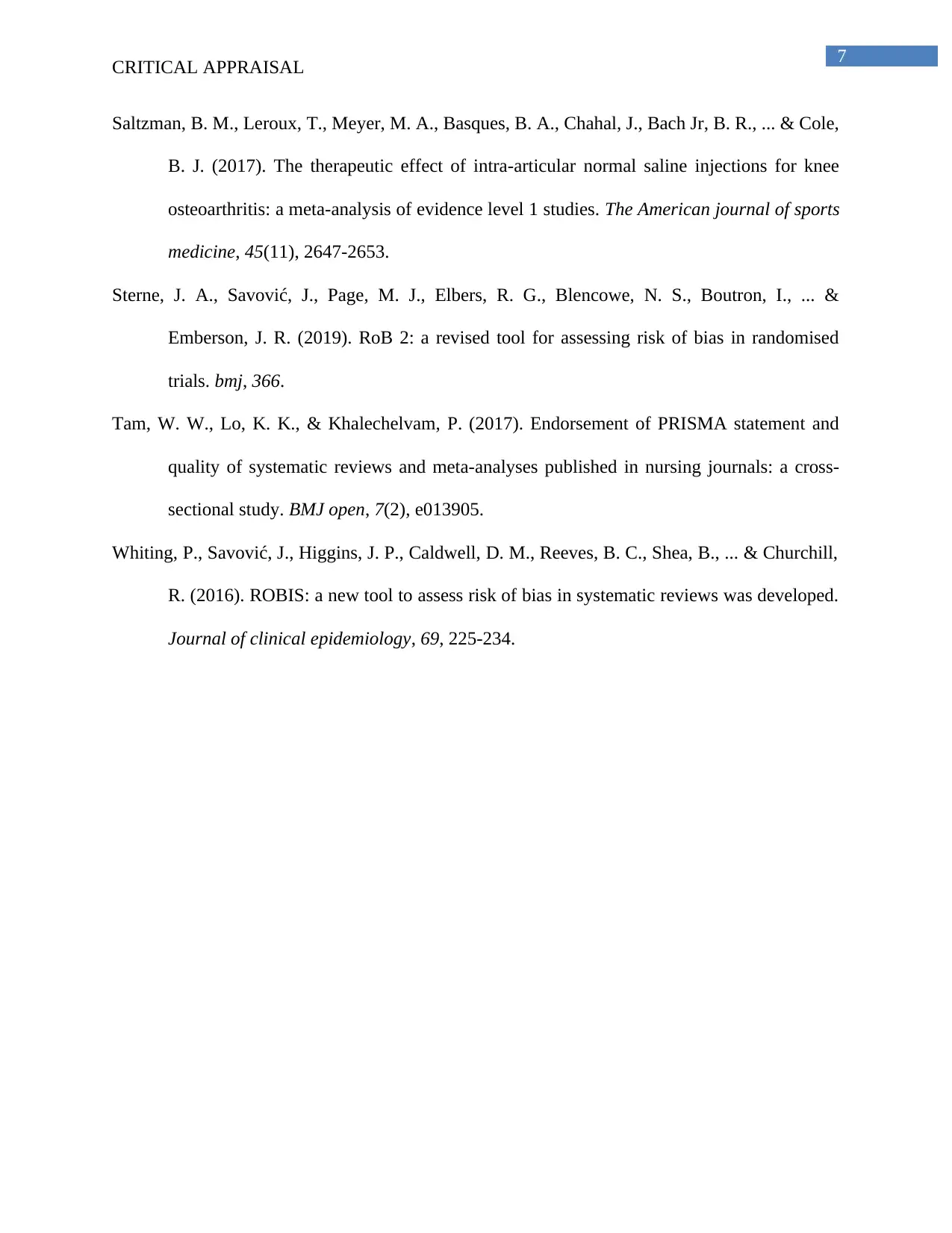
7
CRITICAL APPRAISAL
Saltzman, B. M., Leroux, T., Meyer, M. A., Basques, B. A., Chahal, J., Bach Jr, B. R., ... & Cole,
B. J. (2017). The therapeutic effect of intra-articular normal saline injections for knee
osteoarthritis: a meta-analysis of evidence level 1 studies. The American journal of sports
medicine, 45(11), 2647-2653.
Sterne, J. A., Savović, J., Page, M. J., Elbers, R. G., Blencowe, N. S., Boutron, I., ... &
Emberson, J. R. (2019). RoB 2: a revised tool for assessing risk of bias in randomised
trials. bmj, 366.
Tam, W. W., Lo, K. K., & Khalechelvam, P. (2017). Endorsement of PRISMA statement and
quality of systematic reviews and meta-analyses published in nursing journals: a cross-
sectional study. BMJ open, 7(2), e013905.
Whiting, P., Savović, J., Higgins, J. P., Caldwell, D. M., Reeves, B. C., Shea, B., ... & Churchill,
R. (2016). ROBIS: a new tool to assess risk of bias in systematic reviews was developed.
Journal of clinical epidemiology, 69, 225-234.
CRITICAL APPRAISAL
Saltzman, B. M., Leroux, T., Meyer, M. A., Basques, B. A., Chahal, J., Bach Jr, B. R., ... & Cole,
B. J. (2017). The therapeutic effect of intra-articular normal saline injections for knee
osteoarthritis: a meta-analysis of evidence level 1 studies. The American journal of sports
medicine, 45(11), 2647-2653.
Sterne, J. A., Savović, J., Page, M. J., Elbers, R. G., Blencowe, N. S., Boutron, I., ... &
Emberson, J. R. (2019). RoB 2: a revised tool for assessing risk of bias in randomised
trials. bmj, 366.
Tam, W. W., Lo, K. K., & Khalechelvam, P. (2017). Endorsement of PRISMA statement and
quality of systematic reviews and meta-analyses published in nursing journals: a cross-
sectional study. BMJ open, 7(2), e013905.
Whiting, P., Savović, J., Higgins, J. P., Caldwell, D. M., Reeves, B. C., Shea, B., ... & Churchill,
R. (2016). ROBIS: a new tool to assess risk of bias in systematic reviews was developed.
Journal of clinical epidemiology, 69, 225-234.
1 out of 8
Related Documents
Your All-in-One AI-Powered Toolkit for Academic Success.
+13062052269
info@desklib.com
Available 24*7 on WhatsApp / Email
![[object Object]](/_next/static/media/star-bottom.7253800d.svg)
Unlock your academic potential
© 2024 | Zucol Services PVT LTD | All rights reserved.




